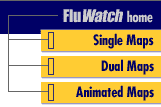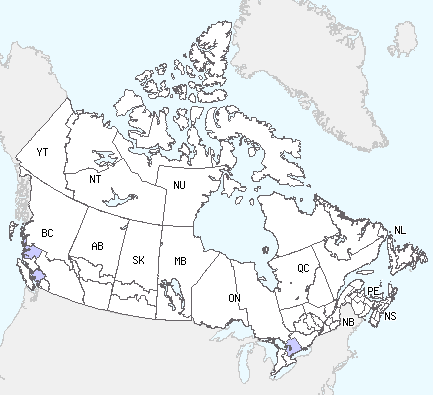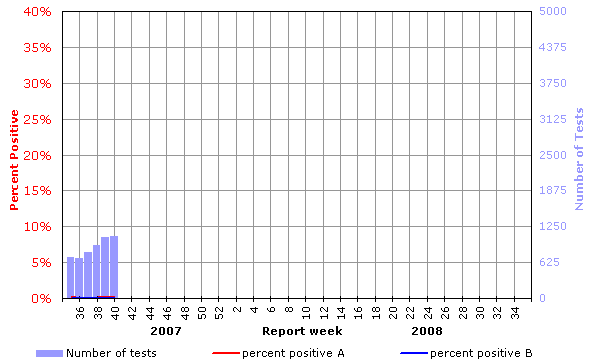Common menu bar links
E-mail this page
Fluwatch
Low influenza activity in Canada
During weeks 39 and 40, influenza activity remained low in Canada
with 3 regions reporting sporadic activity (in British Columbia and
Ontario) (see map). In weeks 39 and 40, only 3
of the 2143 (0.1%) specimens tested were positive for influenza A
virus. The ILI consultation rates increased in weeks 39 and 40
compared to previous weeks (14 and 15 per 1,000 patient visits
respectively) but is within the expected range (see ILI graph). Sentinel response rates for these
weeks were low (46 & 33%) but are expected to increase as the
season progresses. One school outbreak of ILI was reported in BC in
week 40. Since the start of the season, one outbreak in a LTCF was
reported (in Ontario)(see LTCF outbreak
graph). In the current season to date, no new
laboratory-confirmed influenza-associated paediatric
hospitalizations were reported through the Immunization Monitoring
Program Active (IMPACT) network.
Antigenic Characterization:
The National Microbiology Laboratory (NML) has not reported any
influenza strain characterizations for the 2007-2008 influenza
season (see pie chart). However, an updated
set of figures for the 2006-07 season are now available: 276 (27%)
A/New Caledonia/20/99-like, 628 (61%) A/Wisconsin/67/05-like, 13
(1%) B/Malaysia/2506/04-like and 111 (11%)
B/Shanghai/361/2002-like.
Antiviral Resistance:
The NML has not reported any antiviral resistance for the 2007-2008
influenza season.
For PHAC recommendation on antiviral use, please see : PHAC recommendation.
WHO: The WHO has published a summary of the 2006-2007 influenza activity around the world . The report can be accessed at:
WHO vaccine recommendation for Southern Hemisphere:
The WHO has released recommendations for the composition of the
Southern Hemisphere 2008 season influenza vaccine:
It is recommended that vaccines to be used in the 2008 season
contain the following:
- an A/Solomon Islands/3/2006 (H1N1)-like virus (current vaccine virus);
- an A/Brisbane/10/2007 (H3N2)-like virus;
- a B/Florida/4/2006-like virus.
Australia: Influenza activity in Australia has now subsided after a particularly severe season in several states this winter especially in the state of Queensland. During the week ending 29 September 2007, laboratory-confirmed influenza notifications in Australia continued to decline with 69 cases reported compared to 85 in the previous week. The predominant strain circulating in Australia is influenza A(H3).
EISS: In weeks 38 and 39 (up to 30 September 2007), 3 laboratory confirmed cases of influenza in Europe were reported: 2 influenza B and 1 influenza A(H3). There have been no reports of unusual influenza activity in Europe at a community level (i.e. in a region or local area such as a city, county or district since week 22/2007.
Human Avian Influenza: Since 29 September 2007, the WHO reported 3 new cases (2 fatal) of human infection with the H5N1 avian influenza virus in Indonesia. The cases were between 12-44 years of age with symptom onsets ranging from 18 September 2007 to 1 October 2007.
Total number of influenza tests performed and number of positive tests by province/territory of testing laboratory, Canada, 2007-2008
| Province of reporting laboratories |
Report
Period: September 23, 2007 to October 6, 2007 |
Season to
Date: August 26, 2007 to October 6, 2007 |
||||||
| Total # Influenza Tests |
# of Positive Tests | Total # Influenza Tests |
# of Positive Tests | |||||
| Influenza A | Influenza B | Total | Influenza A | Influenza B | Total | |||
| NL | 6 | 0 | 0 | 0 | 14 | 0 | 0 | 0 |
| PE | 7 | 0 | 0 | 0 | 12 | 0 | 0 | 0 |
| NS | 28 | 0 | 0 | 0 | 58 | 0 | 0 | 0 |
| NB | 14 | 0 | 0 | 0 | 35 | 0 | 0 | 0 |
| QC | 372 | 0 | 0 | 0 | 891 | 0 | 0 | 0 |
| ON | 590 | 2 | 0 | 2 | 1282 | 4 | 0 | 4 |
| MB | 89 | 0 | 0 | 0 | 189 | 0 | 0 | 0 |
| SK | 142 | 0 | 0 | 0 | 395 | 0 | 0 | 0 |
| AB | 831 | 0 | 0 | 0 | 2343 | 1 | 0 | 1 |
| BC | 64 | 1 | 0 | 1 | 106 | 1 | 0 | 1 |
| Canada | 2143 | 3 | 0 | 3 | 5325 | 6 | 0 | 6 |
Specimens from NT, YT, and NU are sent to reference laboratories in other provinces.
Note: Cumulative data includes updates to previous weeks; due to reporting delays, the sum of weekly report totals do not add up to cumulative totals.
Abbreviations: Newfoundland/Labrador (NL), Prince Edward Island (PE), New Brunswick (NB), Nova Scotia (NS), Quebec (QC), Ontario (ON), Manitoba (MB), Saskatchewan (SK), Alberta (AB), British Columbia (BC), Yukon (YT), Northwest Territories (NT), Nunavut (NU)
Respiratory virus laboratory detections in Canada, by
geographic regions, are available weekly on the following
website:
<http://www.phac-aspc.gc.ca/bid-bmi/dsd-dsm/rvdi-divr/index-eng.php>
Number of influenza surveillance regions† reporting widespread or localized influenza activity, Canada, by report week, 2007-2008 (N=66)

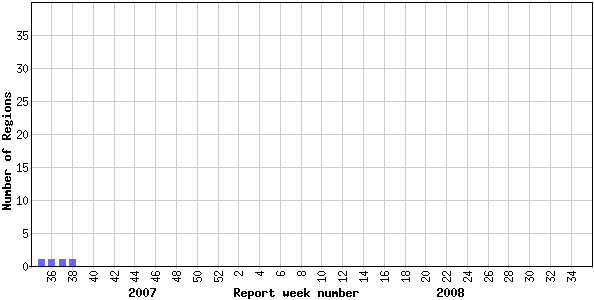
† sub-regions within the province or territory as defined by the provincial/territorial epidemiologist. Graph may change as late returns come in.
Influenza Activity
Level by Provincial and Territorial |
|||||||||||||
|
|||||||||||||
Note: Influenza activity levels, as represented
on this map, are assigned and reported by Provincial and
Territorial Ministries of Health, based on laboratory
confirmations, sentinel ILI rates (see graphs and tables) and
outbreaks. Please refer to detailed definitions. For areas where no data is
reported, late reports from these provinces and territories will
appear on the FluWatch website. Select single maps by
report week to get this updated information. Click on the map to view provinces/territories and maps for other weeks. |
|||||||||||||
Influenza tests reported and percentage of tests positive, Canada, by report week, 2007-2008
Percent positive influenza tests, compared to other respiratory viruses, Canada, by reporting week, 2007-2008
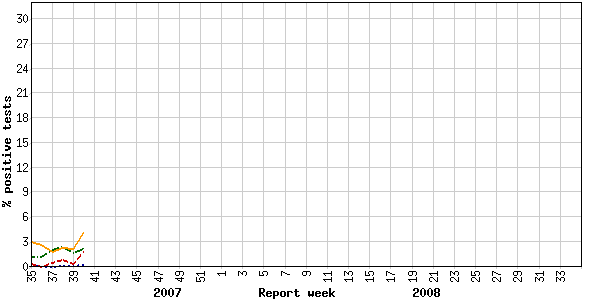

Influenza strain
characterization, Canada, cumulative, 2007-2008 influenza season by
the Respiratory Viruses Section at the National Microbiology
Laboratory
[N=0]

{Strain characterization, number identified, per cent of total number}
NACI recommends that the trivalent vaccine for the 2007-2008 season in Canada contain A/Solomon Islands/3/2006 (H1N1)-like virus; an A/Wisconsin/67/2005 (H3N2)-like virus; and a B/Malaysia/2506/2004-like virus.
Influenza-like illness (ILI) consultation rates, Canada, by report week, 2007-2008 compared to 1996/97 through to 2006/07 seasons


Note: No data available for mean rate in previous years for weeks 19 to 39 (1996-1997 through 2002-2003 seasons).
Number of New Outbreaks in Long Term Care Facilities, Canada, by Report Week, 2007-2008
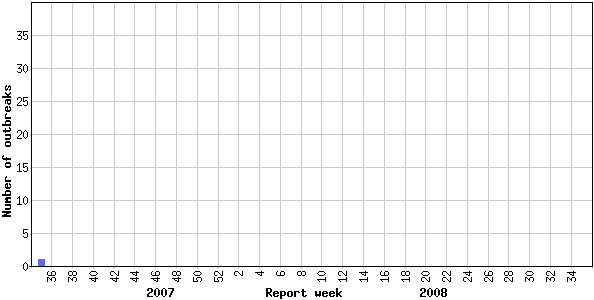

Please note that the above graphs may change as late returns come in.


